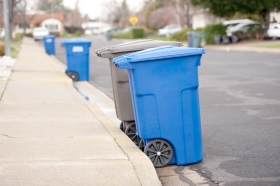Curbside recycling: Preventing a market failure
By Presidio Economics, Triple Pundit
Nobody likes trash: taking it out or talking about it.
It smells, it is a hassle to deal with, and it can be hazardous to your health, which is why we go through great lengths to have it hauled away every week.
Recycling is trash’s cuter brother, with more support because resources are being re-used versus just being thrown out. That is what recycling is at its core: salvaging value from discarded materials.
It is a service that prevents us from maxing out landfills, further depleting resources, or contaminating our soils and drinking water. It also produces considerably less carbon; recycling just 1 ton of aluminum cans conserves more than 1,665 gallons of gasoline.
There are over 9,000 curbside recycling programs throughout the US, which has steadily increased since the 1970s.
The US averages a 33.8 per cent recycling rate, which has gained momentum in the last twenty years but has yet to reach its potential. Studies have shown that 81 per cent of the public agrees that recycling is an important service.
The gap between need and services rendered leads one to wonder why this is the case. Unfortunately, recycling pick-up services are not cheap and it is viewed as a redundant service; extra trucks means extra cost.
On top of that, single stream recycling requires investment in technology to sort the loads efficiently. Trash, on the other hand, is far more indiscriminate because everything just goes to one place, the landfill.
In the short term, one recognizes that the increase in pick-ups adds to the price but this very fee structure fails to include the long-term costs and risks of not recycling thus creating a moral hazard.
The availability of curbside recycling programs varies throughout the country, as does their success. New York City, for example, has led the country as a sustainable city, from green roofs to public transit.
However, physically, it may be one of the dirtiest. New Yorkers want to recycle but recycling numbers fell from 23 percent to 15 percent when the city became strapped for cash.
New York City officials claim say that it is more expensive to recycle than to send trash to landfills and incinerators for disposal, and that they have to weigh those costs against environmental goals.
They are failing to recognize the hazard of not paying attention to the long-term issues regarding trash. NYC might want to reconsider; a little more funding and a better strategy may save them from shipping their garbage to New Jersey, but then again maybe they don’t want that.
In contrast, San Francisco’s recycling program has continued to gain momentum but not without support from their residents and city officials. The city announced a zero waste goal by 2020 and in 2008 they were already at a 77 per cent diversion rate.
The city and Recology, the central waste management company for San Francisco, worked together to come up with a goal and a plan that made sense for this community. They have structured their recycling program to promote the behavior they desire. Curbside fees are charged on a “pay as you throw” basis for trash, while recycling and compost are free, creating a financial incentive for following the law and sorting your waste.
This was only possible through their public private partnership. City legislators reinforced Recology fees and the city needed Recology to be there to do the dirty work.
- Article continues: http://www.enn.com/lifestyle/article/43524?utm_source=feedburner&utm_medium=feed&utm_campaign=Feed%3A+EnvironmentalNewsNetwork+%28Environmental+News+Network%29


























Comments